Pioneer K078 Pedaling Monitor Sensor User Manual Short term Confidential
Pioneer Corporation Pedaling Monitor Sensor Short term Confidential
Pioneer >
Contents
- 1. (Short term Confidential)User Manual
- 2. (Short term Confindetial)User Manual_Safety Notice
(Short term Confidential)User Manual
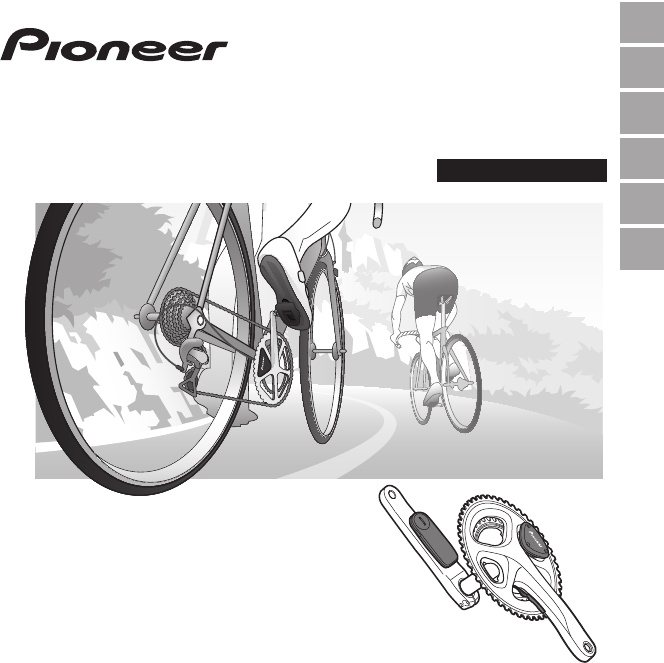
EN
DE
FR
NE
IT
ES
EN
DE
FR
NL
IT
ES
Please read the Important Information for the
User in the product box for product warnings
and other important safety information.
User's Manual
Pedaling Monitor Sensor
SGY-PM910H

2
EN
Introduction
Table of Contents
Introduction
Features ................................................................................................................... 3
Manuals ...................................................................................................................................3
Compatibility ............................................................................................................ 4
Getting Started
Product Conguration .............................................................................................. 5
Accessories.............................................................................................................................5
Installing and Removing the Batteries/Switching Modes ........................................ 7
Pairing /Calibration
Pairing with the Cyclocomputer ..............................................................................10
Calibrating the Sensors ..........................................................................................12
Getting Ready .......................................................................................................................12
Calibrating the Zero Point .....................................................................................................12
Checking the Zero Point .......................................................................................................13
Calibrating in Power Meter Mode .........................................................................................13
Specifications and support
Troubleshooting ......................................................................................................14
Care, Maintenance, and Storage ...........................................................................16
Specications .........................................................................................................17
This product is ANT+™ certied.
Visit http://www.thisisant.com/directory/ for a list of compatible
products and apps.
Introduction

3
EN
Introduction
Features
This product is a sensor system that analyzes the pedaling of a bicycle in
real time. It calculates the direction and intensity of the force acting on the
pedals and calculates pedaling efciency.
Description of components
Strain gauge unit: • Detects the strain on the crank and calculates the direction
and intensity of the force on the crank.
Magnet: • Used to detect the angle of rotation.
Transmitters: • Send information from the strain gauge unit and the
magnet to the Cyclocomputer.
Switching modes
The switch in the right transmitter changes the system to the following modes.
Pedaling mode• : Used in combination with the Cyclocomputer SGX-CA500/
CA900. This mode calculates pedaling efciency and maximizes the
functionality of the product.
Power meter mode• : Used with a Cyclocomputer that supports ANT+™.
Manuals
The product’s manuals consist of this User’s Manual, an Installation Manual, and
Important Information for the User.
User’s Manual:•
Explains how to pair the product with the Cyclocomputer and calibrate the sensors.
Installation Manual:•
[For American Users] http://www.pioneerelectronics.com
[For Canadian Users] http://www.pioneerelectronics.ca
[For European Users] http://www.pioneer.eu
Explains details about handling methods. The product installation methods
(for dealers) are also described as references.
Important Information for the User:•
Important Information for the User provides detailed information related to safety.

4
EN
Introduction
Compatibility
Crank sets
The product is compatible with the following crank sets.
Crank sets Remarks
SHIMANO FC-9000 Crank lengths of 165, 167.5, 170, 172.5, 175 mm, crank set •
of 50-34T, 52-36T, 52-38T, 53-39T, 54-42T, 55-42T are
compatible. *
FC-6800 Crank lengths of 165, 170, 172.5, 175 mm, crank set of 50-•
34T, 52-36T, 53-39T are compatible. *
* Descriptions in this manual are for a 170 mm crank set.
This product is designed to be used for recreational cycling and cycle training
applications only and is not designed to withstand racing conditions.
Additionally, this product is designed to be used while cycling on paved roads
only. Any damage or malfunction arising from use in racing or riding on dirt roads,
cobblestone or any other unpaved roads will not be covered by the manufacturer’s
limited warranty.
Installing and calibrating the product requires specialized techniques and tools. Ask
the shop where you bought the product to install and calibrate it.
Getting Started
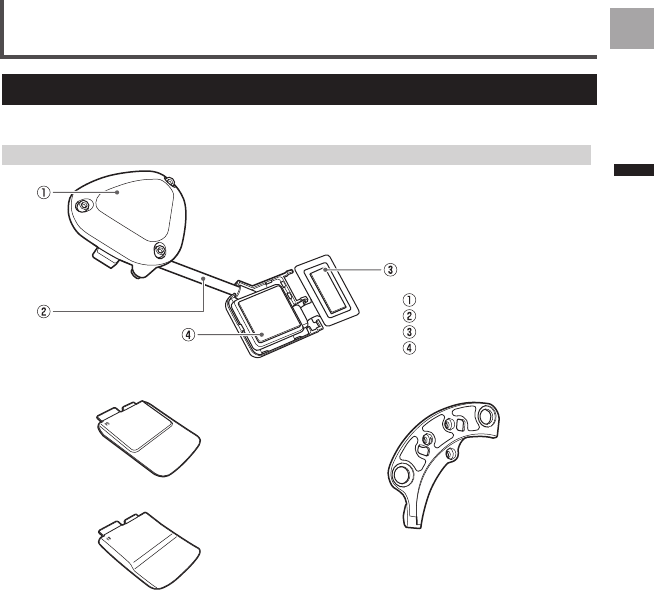
5
EN
Getting Started
Product Conguration
Accessories
This product contains the following parts.
Pedaling monitor sensor (right side)
Right transmitter
Junction cable
Strain gauge unit
Junction box
Pedaling monitor sensor part (right side) x 1
For FC-9000
For FC-6800
Chain ring adapter x 1
Strain gauge unit cover (right side) x 2
Getting Started
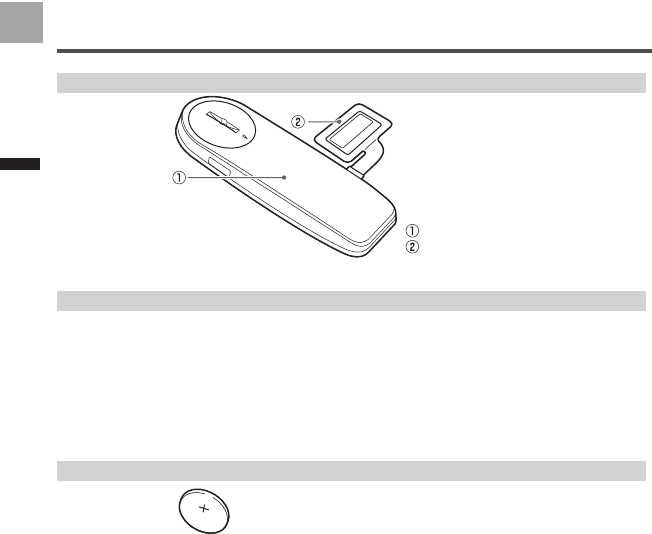
6
EN
Getting Started
Product Conguration
Pedaling monitor sensor (left side)
Left transmitter
Strain gauge unit
Pedaling monitor sensor part (left side) x 1
Magnet
Magnet x 2
Accessories
Phillips-head screws x 10
User's Manual (this document)
Warranty Card
Important Information for the User
Batteries (CR2032) x 2
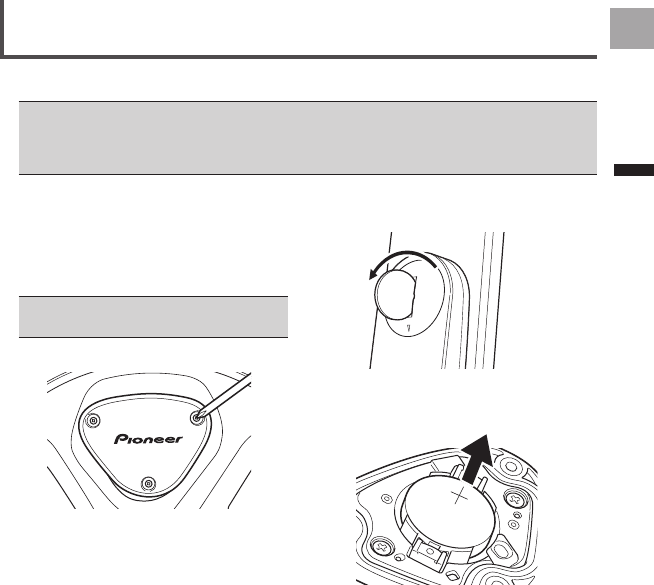
7
EN
Getting Started
Installing and Removing the Batteries/
Switching Modes
You must install the batteries before using the product.
The product can be used as the ANT+ Power meter with the cyclocomputers of other •
companies (power meter mode).
To use the product in power meter mode, insert the battery in the left-side part rst,
and then the right-side part.
1.
Loosen the screws on the
transmitter and remove its
cover.
Use a hex wrench (2 mm) to loosen the
screw and remove the cover.
Be careful not to lose the removed •
screw.
Right transmitter (screws: 3 x)•
Left transmitter (Loosen/tighten •
with coin)
2. Remove the old battery.
Right transmitter•
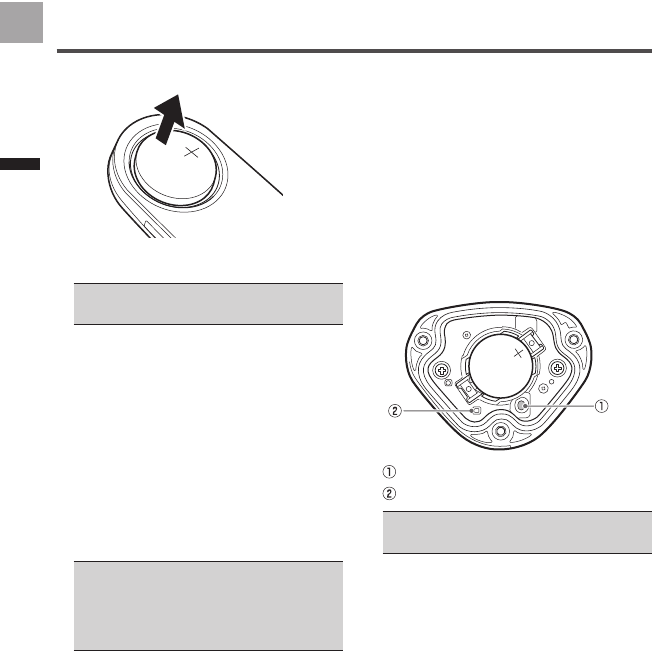
8
EN
Getting Started
Installing and Removing the Batteries/Switching Modes
Left transmitter•
3.
Install the new battery (CR2032).
Do not use batteries other than •
CR2032.
4. Check the LED display.
Check the following LEDs to make
sure that they are working properly.
Pedaling mode• :
When the batteries are installed, the
LEDs light green for 10 seconds.
Power meter mode• :
When the batteries are installed, the
left and right transmitters start pairing.
When pairing is nished, the LEDs
on the left and right transmitters light
green for 10 seconds.
If the LEDs do not light, or only one •
side lights, install the batteries again.
If the LEDs still do not light, the battery
may be almost empty. Replace the
battery with a new one.
5. Start the sensors.
Rotate the bicycle’s crank set one
rotation to start the sensors.
6. Check the sensor modes.
Pushing the push switch in the right
transmitter, the LEDs light as follows
depending on the actual sensor mode.
Pedaling mode• :
The LEDs light green for 5 seconds.
Power meter mode• :
The LEDs light orange for 5
seconds.
Push switch
LED
Make sure that the left and right •
sensors light properly.

9
EN
Getting Started
Installing and Removing the Batteries/Switching Modes
7. Switch the sensor mode.
Change the sensor mode by using the
push switch in the right transmitter
while the batteries are removed.
While in pedaling mode• :
The sensors restart in power meter
mode and the LEDs light orange for 5
seconds.
While in power meter mode• :
The sensors restart in pedaling
mode and the LEDs light green for 5
seconds.
For use with Pioneer’s SGX-CA500/•
CA900, set the sensor mode to
pedaling mode.
For use with other cyclocomputer
brands, set the sensor mode to
power meter mode.
If the left transmitter is not found, the •
LEDs blink red 5 times.
If the LEDs on the left and right •
transmitters do not light the same
color, green or orange, another
left transmitter may be connected.
In this case, check that both side
transmitters light properly in a
location away from any other left
transmitter, and then switch the
sensor modes.
8. Install the cover and tighten
the screws to x it in place.
Use a tool that can measure the torque
to tighten the screws.
Tightening torque: 18 cN·m•
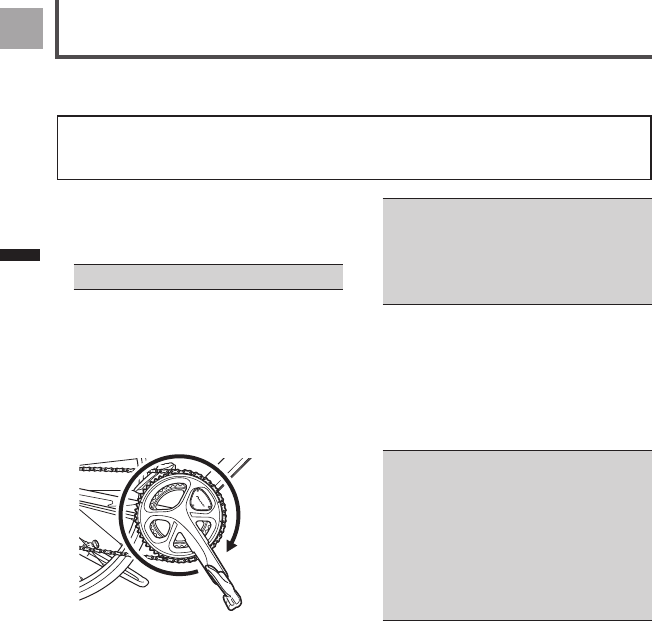
10
EN
Pairing /
Calibration
Pairing with the Cyclocomputer
This section describes how to pair the installed SGX-PM900 pedaling
monitor sensors on your bicycle to the SGX-CA500/CA900 Cyclocomputer.
This pairing procedure may be different if you are using a cyclocomputer other ●
than the Pioneer SGX-CA500/CA900. Please refer to your cyclocomputer’s
owner manual for sensor pairing.
1.
Check the sensor modes.
Check that the right transmitter and the
left transmitter are in "Pedaling mode."
See page 8 to switch the modes.•
2.
Tap the [Sensors] icon in the
home screen of the SGX-CA500/
CA900.
The sensor list screen opens.
3. Rotate the bicycle’s crank set
three rotations to start the
transmitter.
Pair with the Cyclocomputer within •
5 minutes after the transmitters are
activated.
After the transmitters are activated, it •
may take more than 1 minute to pair
with the Cyclocomputer.
4.
Tap [Connect New] in the
sensor list screen of the
SGX-CA500/CA900.
The sensor connection menu opens.
5. Tap [Device Type] and then
[Pedaling Monitor R].
For the left transmitter, tap [Pedaling •
Monitor L].
If multiple sensors are activated, •
bring the main unit closer to the
sensor, or specify the device number
to pair the sensor you want to pair.
Refer to the User's Guide of the
Cyclocomputer SGX-CA500/CA900
regarding how to specify a device
number to pair a sensor.
Pairing /
Calibration
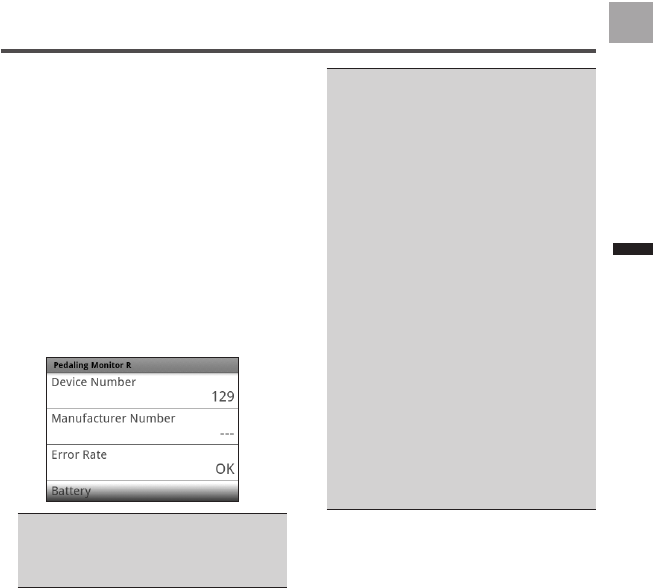
11
EN
Pairing /
Calibration
Pairing with the Cyclocomputer
6. Tap [Search].
The search for the sensor starts.
A [Searching. Please wait.] message
appears.
7. Check the information about
the sensor.
Information about the sensors appears
when the sensors are found.
Check the following items.
[Device Number]•
Make sure that the device number
is the same as the device number
of the transmitter.
[Error Rate]•
Make sure that “OK” is displayed.
The device numbers are printed on •
the right junction box and on the
side of the left sensor. Refer to the
Installation Manual for details.
If the numbers that are displayed on •
[Device Number] are different from
the transmitter device numbers,
specify the device numbers to pair
with the sensor.
Refer to the User’s Guide of the
Cyclocomputer SGX-CA500/CA900
regarding how to specify a device
number to pair a sensor.
If “NG” is displayed in the [Error •
Rate] area, the information from the
sensor is not being received correctly
because transmission conditions are
bad. Make sure that the sensor you
are pairing is activated, then bring
the SGX-CA500/CA900 closer to
the sensor and perform the pairing
operation again.
You may not pair with the sensor •
due to the inuence of the 2.4 GHz
frequency band. If “NG” is displayed
even if the SGX-CA500/CA900 is
moved closer to the sensor and
paired with it, try again someplace
where there is no interference from
microwaves, radio waves, or wireless
equipment.
Pairing of the right transmitter is
completed.
Then, pair the left transmitter.
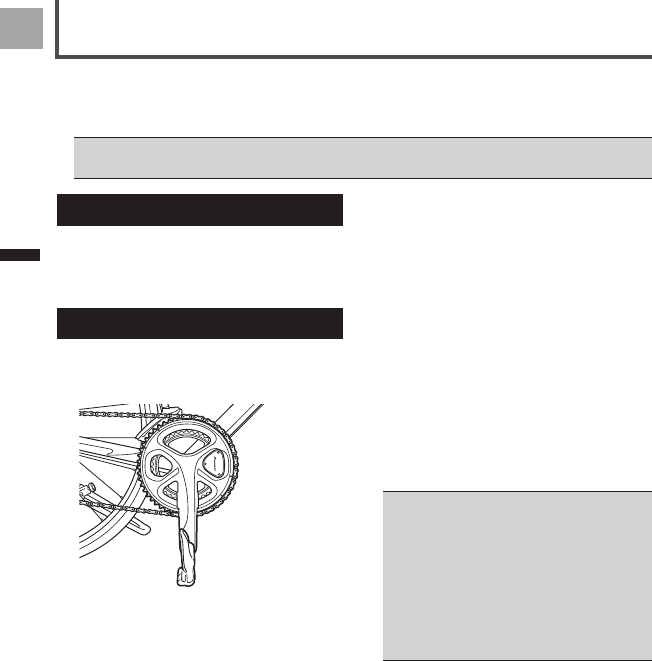
12
EN
Pairing /
Calibration
Calibrating the Sensors
This section describes how to use the Cyclocomputer SGX-CA500/CA900 to
calibrate the zero point of the pedaling monitor sensor that is installed on the
bicycle.
The right-side pedaling monitor sensor is used as an example in this description. The •
procedure to calibrate the left side is the same as for the right side.
Getting Ready
1. Stop the bicycle on a at safe
place.
Calibrating the Zero Point
1. Position the crank arm so it is
perpendicular to the ground.
2. Tap the [Sensors] icon in the
home screen of the SGX-
CA500/CA900.
The sensor list screen opens.
3. Tap [Pedaling Monitor R] and
then [Calibration (Zero)].
4. Tap [Start Calibration].
The calibration starts.
If the calibration is successful,
“Success” appears in the [Result] eld.
If “Failure” is displayed, the sensor may
be calibrated in an unstable condition
causing the crank to be moving during
the calibration. Calibrate again with the
crank stopped.
This product has a correction •
function for the zero point uctuation
caused by varying temperatures. The
accuracy of this function improves
when the sensor is calibrated in
different temperatures.
This function cannot measure
correctly if you calibrate or check the
sensor before it is acclimated to the
outside temperature.
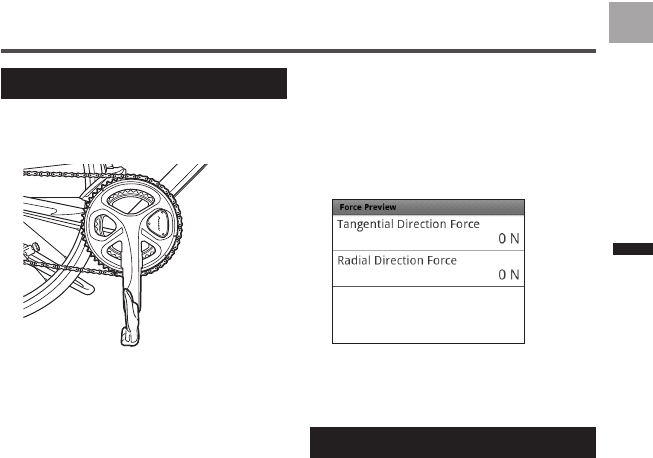
13
EN
Pairing /
Calibration
Calibrating the Sensors
Checking the Zero Point
1. Position the crank arm so it is
perpendicular to the ground.
2. Tap [Pedaling Monitor R] in
the sensor list screen of the
SGX-CA500/CA900.
3. Conrm the value in [Force
Preview].
Make sure that the [Tangential
Direction Force] and [Radial Direction
Force] values are as shown here.
Tangential Direction Force: 0 ± 3 N•
Radial Direction Force: 0 ± 3 N•
Calibration of the right side is
nished. Calibrate the left side in the
same way.
Calibrating in Power Meter Mode
When calibrating the sensors in power
meter mode, position the crank arm
so it is perpendicular to the ground, do
the procedure to the left and right sides
together. Refer to the User’s Manual of
the Cyclocomputer you are using for
details.
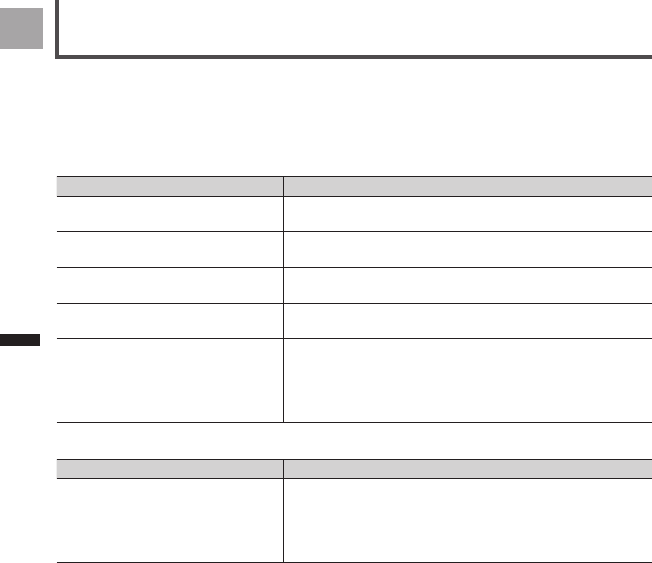
14
EN
Specications
and support
Troubleshooting
Refer to the following suggestions if you have any problems installing or
using the product.
If you cannot nd what you want to know here, ask the shop where you bought
the product.
I cannot pair with the Cyclocomputer in the power meter mode or pedaling mode. ■
Cause Solution
The battery is almost empty. If the LEDs do not light when you install the battery, the
battery is almost empty. Replace the battery with a new one.
(+) or (-) side of the battery is
installed in the opposite side.
Install the battery in the proper side (see page 7).
Pedaling monitor sensor mode is
wrong.
Change the mode and pair with the Cyclocomputer (see
page 8).
There are other wireless equipment
or microwave ovens near by.
Separate other wireless equipment or microwave ovens.
Move the sensor closer to the Cyclocomputer and pair them.
Another sensor is paired with the
Cyclocomputer.
Insert the battery in the left-side part rst, and then the right-
side part, and check the sensor mode by pushing the push
switch. If the left and right LEDs do not light orange, push
and hold the push switch to switch to power meter mode.
Ask the shop where you bought the product for details.
I cannot pair with the Cyclocomputer in the power meter mode. ■
Cause Solution
Pairing between right and left
sensors fails.
Insert the battery in the left-side part rst, and then the
right-side part, and check the sensor mode by pushing the
push switch. If the left and right LEDs do not light orange,
push and hold the push switch to switch to power meter
mode.
Specications
and support
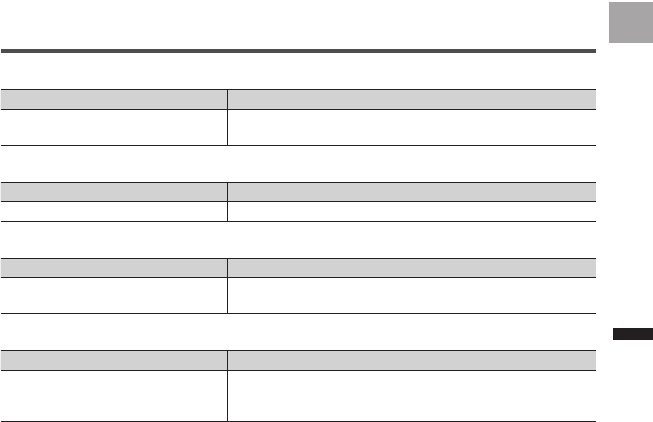
15
EN
Specications
and support
Troubleshooting
Zero point calibration fails. ■
Cause Solution
The crank is subjected to external
force or moving.
Calibrate the sensor in still condition (see page 12).
The Cyclocomputer display is not displaying normally while I am riding. ■
Cause Solution
Zero point calibration fails. Calibrate the zero point (see page 12).
There is a rattling noise when I am riding. ■
Cause Solution
Screws used to install the sensor
are loose.
Retighten the screws.
The magnet is rubbing while I am riding. ■
Cause Solution
Foreign objects are attached to
the magnet and rub against the
transmitter or the junction box.
Clean the transmitter, junction box, and magnet.

16
EN
Specications
and support
Care, Maintenance, and Storage
Use a soft dry cloth or a cloth that has been dampened and wrung out to wipe •
dirt from the left and right transmitters, the right strain gauge unit cover, the
magnet, and other accessories.
Do not use benzene, paint thinner, or other volatile chemicals, cleansers, or •
chemically treated cloths. Doing so could damage the product or cause the
paint to peel off.
If you are not going to use the product for a long period of time, remove the •
batteries.

17
EN
Specications
and support
Specications
Weight: 73 g
Dimensions: Pedaling monitor sensor (right side):
Right transmitter:•
60.7 mm(W) × 46.9 mm(H) × 21.6 mm(D)
Junction box, Strain gauge unit cover:•
63.3 mm(W) × 47.2 mm(H) × 9.9mm(D)
Pedaling monitor sensor (left side):
99.4 mm(W) × 48.2 mm(H) × 14.6 mm(D)
Magnet:
φ57.0 mm × 3.5 mm
Water resistant: This device has a water resistance rating of IPX-6/IPX-7.
Communications method (sensors): ANT+ wireless
Battery: CR2032
Battery operating time: Approximately 200 hours (at moderate temperature)
Operation temperature: -10 to 50°C
Accessories: Magnet, Chain ring adapter, Batteries (CR2032),
Cable ties, Phillips-head screws,User’s Manual,
Important Information for the User,
Warranty Card
The battery operating time may decrease depending on the usage condition. •
ANT+ is a Wireless Personal Network protocol with very low power •
requirements using 2.4GHz frequency band.
For more information, visit http://www.thisisant.com/
Specications and design are subject to change without notice.•
Illustrations used in this manual may be different from actual appearance.•

©2012 PIONEER CORPORATION.
All rights reserved.
<Z-912-021-11> EU
http://www.pioneerelectronics.com
http://www.pioneerelectronics.ca
http://www.pioneer.eu
Visit www.pioneer.eu to register your product.
Visitez www.pioneer.eu pour enregistrer votre appareil.
Si prega di visitare il sito www.pioneer.eu per registrate il prodotto.
Visite www.pioneer.eu para registrar su producto.
Zum Registrieren Ihres Produktes besuchen Sie bitte www.pioneer.eu.
Bezoek www.pioneer.eu om uw product te registreren.
PIONEER CORPORATION
1-1, Shin-ogura, Saiwai-ku, Kawasaki-shi, Kanagawa 212-0031, JAPAN
PIONEER ELECTRONICS (USA) INC.
P.O. Box 1540, Long Beach, California, 90801-1540, U.S.A.
TEL: (800) 421-1404
PIONEER ELECTRONICS OF CANADA INC.
340 Ferrier Street, Unit 2, Markham, Ontario, L3R 2Z5, Canada
TEL: 1-877-283-5901
TEL: 905-479-4411
PIONEER EUROPE NV
Haven 1087, Keetberglaan 1, B-9120 Melsele, Belgium/Belgique
TEL: +32 (0)3 570 05 11